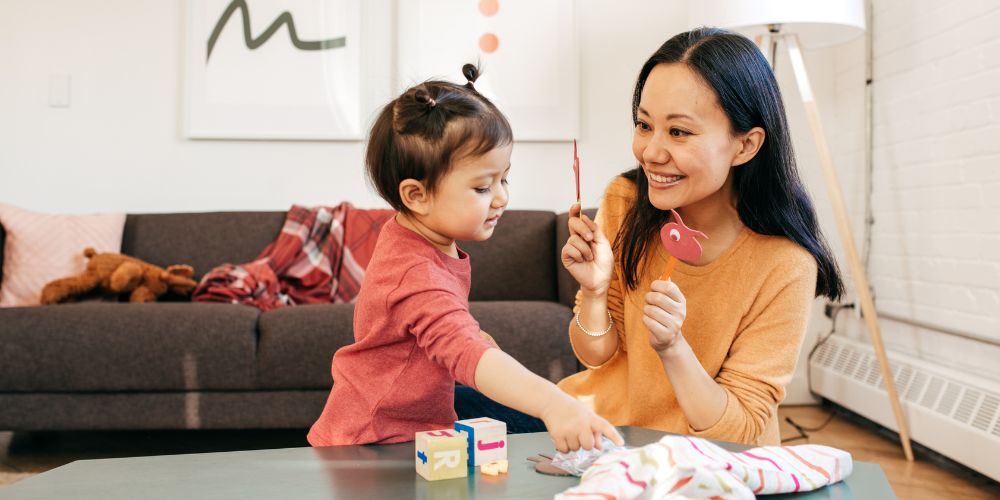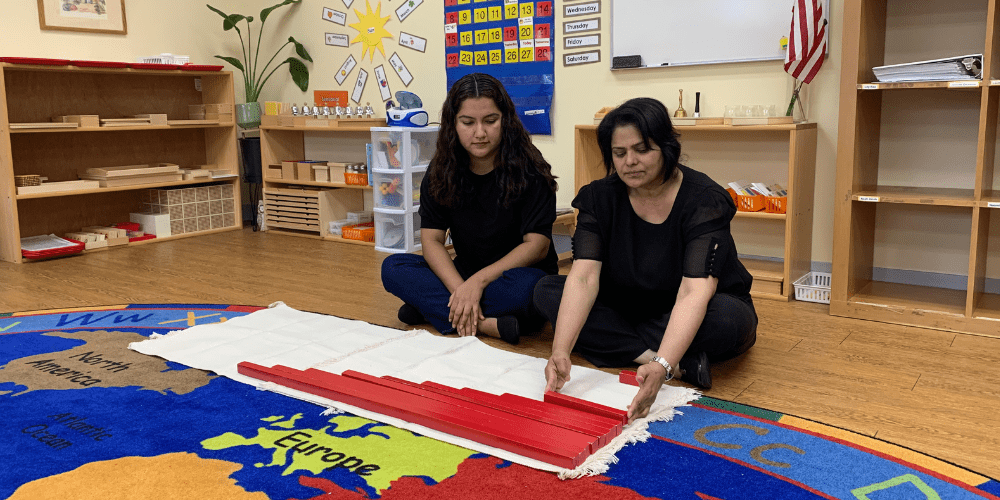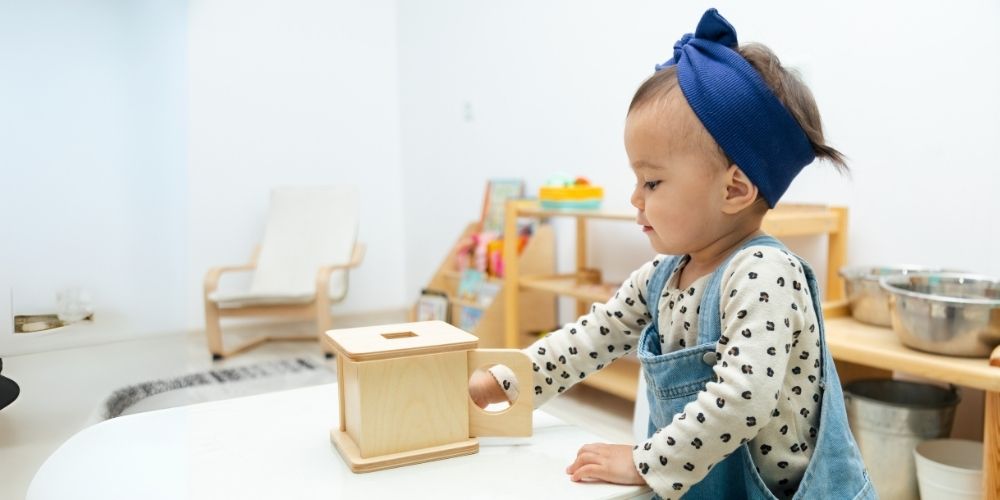Why a Montessori Home?
Whether your child is already enrolled in a Montessori school or you are thinking about enrolling them in the future, we encourage you to explore the benefits that a purposefully prepared home environment can offer your child. A thoughtfully prepared and child-accessible environment allows children to learn how to care for the space around them and is the first step in helping children develop competence, independence, and confidence. Creating a Montessori-inspired home environment can also be helpful in creating an invaluable bridge from school to home, reinforcing what your child is learning at school and giving them additional time to practice the new skills they are acquiring. Below are a few practical steps you can take to implement the Montessori approach in your home.
Incorporating Montessori Principles At Home
Montessori philosophy emphasizes organized home environments in order to provide your child with structure, independence, and self-motivation. Your child is actively learning from and engaging with the space around them everyday, and by observing how they learn best you can become a source of specific encouragement. Take a step back and observe your child as they play and interact at home – how does your child focus best? It may be in their own quiet space or perhaps they like to be in the family room with music or background noises. Close observation also involves actively listening to your child, engaging in conversations with them, validating their feelings, and encouraging them to share their thought process. Next time you pick your child up from school, listen to them explain how their day went, acknowledge if it went well or badly, and show genuine interest in learning more about their interactions with others and with their lessons. Be careful of falling into the trap of praising your child rather than encouraging them – excessive, long-term praise can inhibit children from gaining independence because they can become dependent on the praise of those in authority positions, rather than being internally motivated.
It’s also helpful to emphasize practical life skills for your child, which will prepare them to take responsibility for themselves and build their sense of self. Asking your child to put their worn clothes in the hamper or put their toys where they belong at the end of the day will help instill the habit of cleaning up after themselves and your child will be more inclined to begin creating independent habits, further respecting their space as a courtesy.
Creating a Prepared Environment At Home
Do you notice any similarities between your home and these photos?
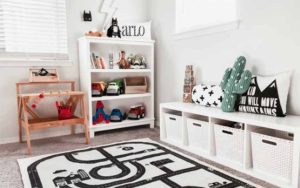
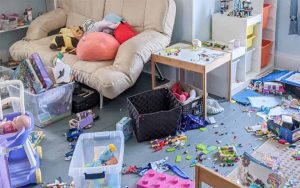
If your home resembles the first photo, great! With furniture at the child’s level and ample spaces to put items away independently, you are already on a great path to helping your child live in a prepared environment set up in a way that they can become self-sufficient. If the second photo resembles your home, no need to worry; you can always make ongoing adjustments when creating a prepared environment for your child.
When you curate an organized home for your child, you can expect to see your child develop increasing competence in caring for themselves and their environment. Let’s explore how different areas of the home can become prepared, walking through the most common areas of your home.
Entryway/Mudroom
Picture this: you enter your home and in the entryway or mudroom your child independently places their shoes on the shoe rack. Your child is able to identify where to correctly place their shoes because the space is organized & accessible to them. A child who is provided with organizational resources and the opportunity to practice daily routines naturally has the capacity to think and act autonomously, making everyone’s lives easier! If you have the space you can also set up child-size & height hooks for your child to hang their backpack or coat each day.
Family/Living/Playroom
In a family, living, or playroom it is best to separate your child’s belongings from yours. Try placing your child’s toys in accessible storage containers categorized and labeled by the type of toy; use clear or colored bins to denote the types of toys.
Explain to your child that when they are finished using their toys, they are to be placed back into the correct place that you have organized together. You can even create labels (with words or pictures) to help remind them! Eventually, your child will build the habit of cleaning up behind themselves and will feel a sense of ownership of the space themselves.
You can also try rotating out your child’s toys every few weeks: you may find that your child is overwhelmed by the number of choices they have to play with and yet still complains they are bored. Simplifying the items makes it easier for your child to make a decision about what toy or activity they would like to use, while rotating and reintroducing items after a period of time also helps children not become bored with their toys because they do not have access to all of them at the same time.
Kitchen/Dining Room
Meals and snacks can become an easier process when the kitchen or dining room is set up for a child. Invest in a cabinet or pantry space that is aligned to their height, so grabbing a snack or dinnerware independently becomes a new norm. Young children can also help with the dishes whether it is loading or unloading the dishwasher, or helping dry hand-washed items! Although the process takes a little longer, your child will feel fulfilled if you allow them to help with the chores and contribute to the household.
We also recommend purchasing a step stool for your child so they can participate in making meals! When children participate in the meal prep process they are more likely to be interested in trying new things. You can purchase child-safe knives and other utensils, continuing to teach your child those practical life skills that they can build on that will carry them through life.
Bedroom/Sleeping Space
Sleep is so crucial for growing children, and so ensuring their room is a safe space to retreat and rest is important. Your child’s bedroom should be as intuitive as possible for them while also allowing the space to be an expression of your child’s unique personality and interests (this can be done through decoration and paint choice).
A made bed or organized closet enables independent daily habits. Showing your child what a clean bedroom looks and feels like will allow them to understand how to respect their space. Child-size furniture allows you to store their clothing in low drawers or you can place a closet rod within reach of your child to hang their own clothes. For younger children, you can label the dresser with photos of the items that go in each drawer so they can put clean clothes back into the right place.
Providing an analog clock or a child-friendly clock with light indicators will also help your child know the boundaries of sleep vs. play time, and promote further independence. You can also use our printable routine cards to set up a morning and evening routine with your child. This helps so they know what to expect and to eventually take ownership of their daily routines.
Bathroom
In your child’s morning or night routine, the bathroom is where they increase their self-reliance because they are potty training and cleaning themselves. Organizing the bathroom to be accessible to your child can look like providing a step-stool to reach the sink to wash their hands and brush their teeth, or mounting a low hook for them to independently hang their towel.
While considering each room individually may seem like a lot of areas to tackle, do not rush – take the time to carefully curate your prepared environment spaces, and involve your child in the process to ensure the setup is a good fit for their age and developmental abilities. Effort and patience will be required as your child adapts to their new environment, and their environment and routines can and will evolve over time as your child continues growing.
Embracing the Montessori Parenting Approach
There are several ways you can prepare yourself to become a ‘Montessori parent’. First, determine your role in supporting your family’s Montessori practice at home. A good practice is committing to adapting to your child’s interests, modeling household responsibilities, engaging with your child, practicing real-life skills, and building your child’s inner motivation.
When possible, a parent who can adapt to their child’s interest should make an effort to pursue it further: for example, if your child loves to dance to classical music, enrolling them in a ballet class is a great first step. When introducing a new skill to your child, watch how they respond and how quickly they are motivated to practice. Upon mastery of a new skill, children take initiative and pride in being able to do the skill independently.
It’s important to practice real-life skills with your child. A home that encourages helpfulness is a home where order revolves around sharing responsibility and skills. Inviting your child to be involved and help manage household responsibilities will provide the practice needed to eventually produce capable and independent teenagers and young adults. Some skills your child can help with are putting their shoes away, dusting furniture or organizing shelves, putting their clothes in a hamper or sorting clean clothes into drawers.
Creating a Montessori home is a work in progress. If you want to learn more about incorporating Montessori into your home and daily routines, check out our Montessori Monday Recording here.
For more information about how a Montessori School can impact your child’s education and future, you can learn more about CMMS & schedule a tour here.

